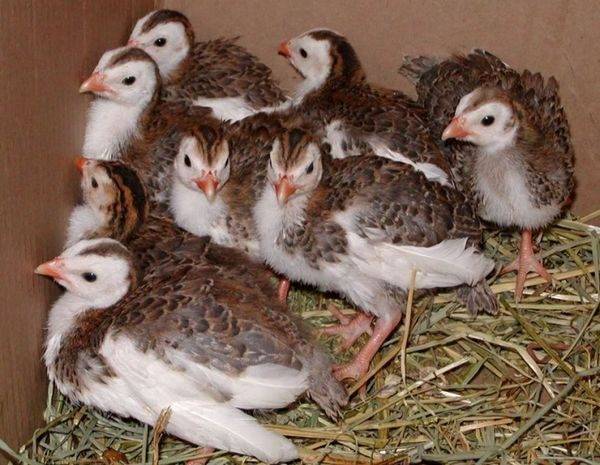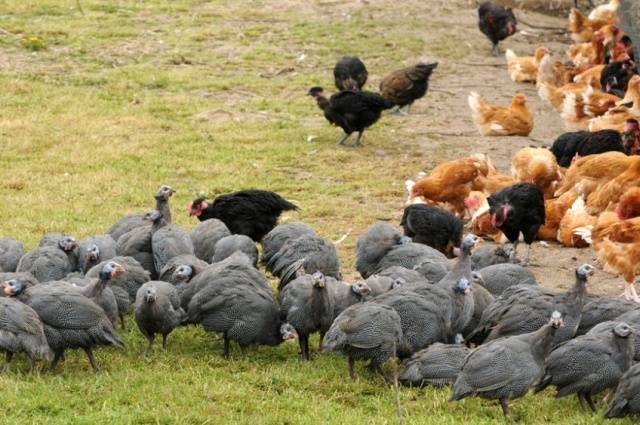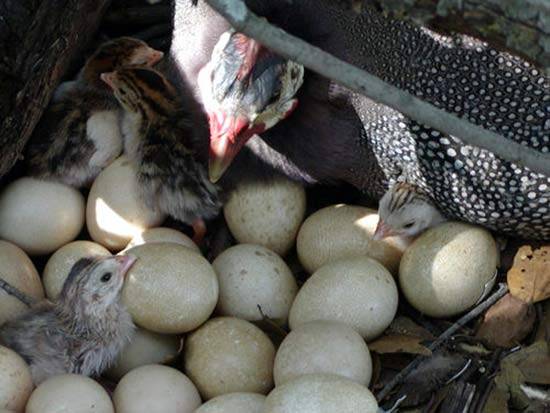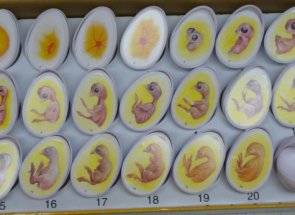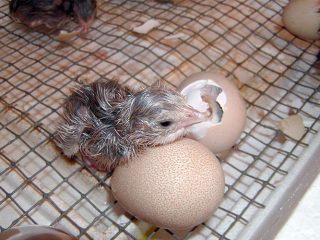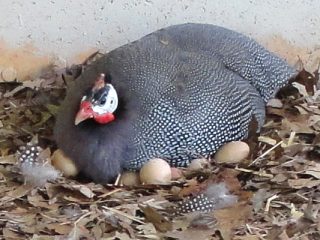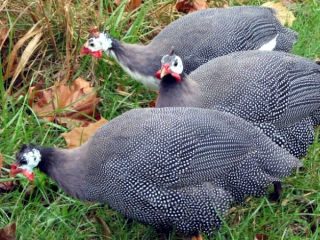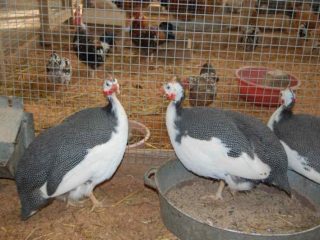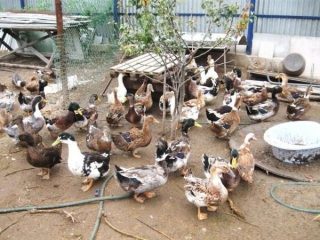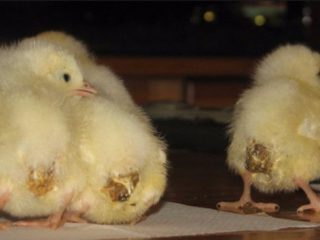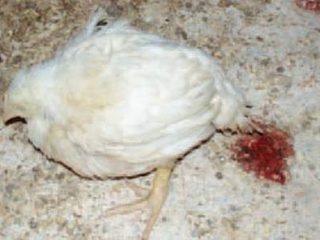Content
In the case of a decision on breeding guinea fowls, the question of what age the bird is better to buy is first of all resolved. From the point of view of economic payback, it is more profitable to buy grown birds, since they are more likely to sit on eggs. But the question arises when the guinea fowls begin to lay eggs and how old the bird should be in a particular month in order for it to start laying eggs in the spring.
At what age do guinea fowls begin to rush
The term of puberty in females normally occurs at 8 months, but the time of the beginning of egg-laying depends not only on age, but also on the conditions of detention. Under normal conditions, guinea fowls usually begin to lay in February-March at the age of 9-11 months.
The fact that the caesars later become sexually mature means that in the case of buying birds of the same age, at first the eggs of the guinea fowls will be food, since the male was not yet able to fertilize them.
Therefore, if suddenly the seller claims that he is selling an industrial breed that starts laying eggs as early as six months, this is not true. At home, this guinea fowl will start laying at the usual 9 months. Of course, provided that the already "accelerated" bird was not purchased.
The number of eggs that one guinea fowl can lay is different for each breed. But the general rule is that the length of the period during which the guinea fowls are carried affects the number of eggs laid. In good layers, lay breaks are short and the cycles are longer than the breed average per lay.
With the cage keeping, more eggs are obtained from the guinea fowls than with the floor, since under artificial conditions it is possible, due to lighting, to shift the dates when the guinea fowls begin to lay to the winter months.
But with cellular content, you can only get a food egg. To obtain a fertilized animal, the optimal conditions for keeping is a room with the possibility of walking.
Walking in birds improves metabolism and stimulates sexual behavior.
In addition, even at home, you can ensure that the guinea fowl lay more often than one egg per day. To do this, with the help of artificial lighting, the birds are set a 16-hour day. As a result, guinea fowl can produce 3 eggs in two days. But such a regime exhausts the body of the guinea fowl.
The very first eggs that guinea fowls bring (usually February and March) are too small and are not suitable for hatching chickens.
Breeding methods for guinea fowl
There are two ways: incubator and hen. If the option with a hen is chosen, then you should not expect a large number of eggs from the guinea fowl per season, since she will not have an incentive to continue laying.
Breeding chicks with a brood hen
To incubate chickens, the guinea fowl usually looks for a secluded place. In this case, the eggs should not be disturbed. Birds are very shy and if you touch the nest, they leave it and go to rush to another place.
Before incubating, the guinea fowl lays about 20 eggs, after which it sits tightly on the eggs. Guinea fowl eggs are smaller than chicken eggs, but the basic law: the smaller the egg, the faster the chicks hatch, in the case of guinea fowls it does not work.The main difference that makes it difficult for guinea fowls to hatch under a chicken is the timing of how many guinea fowls hatch eggs. Guinea fowl incubates eggs for 25 to 28 days. That is, in fact, this is the timing of the turkey.
Guinea fowl should not be disturbed when it sits on eggs, therefore, at home, birds are made closed nests indoors. It is better not to enter these poultry houses by outsiders.
To breed chicks, brood hens need confidence in safety and peace of mind.
At the same time, if the guinea fowl decides to nest, then it can become very aggressive.
Comment! Guinea fowls are hatched uncommonly. The withdrawal can take two days.
If in the case of an incubator this does not really matter, then under the hen, the previously hatched chicks, having dried, can go to explore the world while the mother sits on the remaining eggs. Or the hen will abandon the half-hatched guinea fowls and go to nurse the first batch.
Incubator hatching
During incubation, only medium-sized eggs are used, the correct shape and a smooth whole shell. You can check for microcracks in the shell by knocking the eggs against each other. If cracked, the sound will be rattling.
There is no need to be afraid to break the shell with a light tapping. Guinea's eggs have a very strong shell. Such a shell allows you to store guinea-fowl eggs much longer than chicken eggs, without fear that they will deteriorate.
Also, before laying the egg, it is necessary to illuminate with an ovoscope to make sure that there are no blood clots inside.
In the incubator, guinea fowl eggs can be kept together with chicken eggs, incubating in the "chicken" mode. But it is better if they are incubated separately. Since in nature, the female can hatch chicks only during the dry period and the eggs during hatching are in much more severe conditions than those of chickens.
When incubating guinea fowls in an incubator, they maintain a lower humidity than incubating any other poultry. Thick shells and a strong film will keep the contents from drying out.
This is explained by the fact that it has a very powerful defense against the penetration of pathogenic bacteria. But water from the inside can seep out and evaporate.
Chicken embryos are usually checked on days 7 and 14 by discarding spoiled eggs. Caesarians recommend looking only at 21-23 days. At this time, it will be seen if the embryo inside froze. Unfortunately, in many guinea eggs, the chick will be dead.
But this method works only just before hatching, when the chick begins to actively move and punch a hole in the air chamber with its beak.
Place the egg on an upside-down sieve. An egg with a dead chick will remain motionless, with a live one it will roll on the net. It will not be able to fall, the sides will prevent it.
After hatching, the chicks are placed in a brooder and provided with quality feed. Caesarians do not require special feed, they can be fed with regular starting compound feed for chickens. The presence of all the necessary nutrients, vitamins and minerals will ensure rapid growth of the guinea fowl.
In brooders, guinea fowls are kept, depending on the weather, either until they fledge, or even longer. But you need to monitor the temperature. During the first days, it should be high enough so that the Caesars would not freeze.
Once you step out of the range of the lamp and the air will be too cold for hot skin heated by infrared radiation. This can lead to a cold of the guinea fowl, even in a brooder. Better to use conventional incandescent bulbs or heating elements.
Later, the temperature in the brooder is gradually reduced. With an incandescent lamp, this is especially convenient, since you can simply reduce the temperature by changing the lamps to less powerful ones.
Principles of feeding and keeping the main herd
To obtain the maximum number of fertilized eggs, laying females and breeding males are provided with compound feed for layers that stimulates egg-laying and is rich in vitamin E. It is necessary to provide birds with high-quality feed even before laying. Normally, it takes a month for laying hens to prepare for a cycle.
Sometimes this does not help and the birds that laid eggs last year, this year they stubbornly refuse to do this, not paying attention to the fact that it is not even February, but April in the yard. The reasons are often unknown, since the owners did not change the feeding.
Advice! When the reasons why the guinea fowls stopped laying are unknown, you can try giving them boiled potatoes for several days. Often, after potatoes, birds begin to lay eggs.
If you give last year's potatoes, you need to break off the sprouts and drain the water after cooking.
At home, birds are best kept not in cages, but in a poultry house, where they can be provided with deep bedding and nesting boxes below and perches above. Guinea fowls fly much better than chickens and a perch with a height of one and a half - two meters is quite capable of them.
Although egg-laying in guinea fowls begins in winter, they scatter these eggs everywhere and are not going to sit on them. They will try to nest only with the onset of warm days.
If it is necessary to control the laying, then the birds are left in the house in the morning, providing them with food and water. After dinner, the laying hen should be laid down.
So, after all, what is more profitable: raising a breeding herd of eggs or chicks or buying already grown young? Young animals can cost significantly more than eggs, even taking into account the further cultivation and feeding of hatched guinea fowls. But you will not have to worry about the survival rate and take care of the Caesars all summer.
The hatching egg must be purchased in the spring so that the birds can grow. The grown young growth can be taken in the fall.
In terms of feed, sometimes chicks can be even more profitable if there is access to cheap or free feed. But this is rare. In addition, such feeds usually do not provide the bird with all the necessary substances.
To get a good offspring with high-quality feed, both the broodstock and the young stock fed for meat must be provided.
